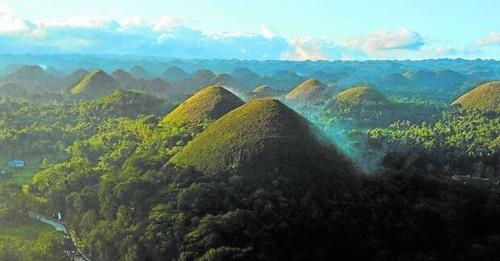
NATURE’S WONDER Bohol’s Chocolate Hills, according to a 1988 government declaration, were formed ages ago by coral deposits and the action of rainwater and erosion. This unique landform found in the towns of Carmen, Batuan and Sagbayan earned its famous name as the verdant grass covering the mounds turns brown during the dry season. —PHOTO COURTESY OF VAN CLAYTON RESPONTE
TAGBILARAN CITY—Bohol, home of the iconic Chocolate Hills and one of the world’s best diving destinations, has been recognized as the Philippines’ first global geopark by the cultural agency of the United Nations.
The United Nations Educational, Scientific and Cultural Organization (Unesco) has declared Bohol as one of the 18 new global geoparks, bringing the total number of sites to 195 in 48 countries. The Unesco global geopark label, created in 2015, recognizes geological heritage of international significance.
“Geoparks serve local communities by combining the conservation of their significant geological heritage with public outreach and a sustainable approach to development,” read Unesco’s statement on its website. The announcement was made during the 216th Unesco executive board session held in Paris on Wednesday.
Unesco also cited Bohol’s Danajon Double Barrier Reef, consisting of two sets of large offshore coral reefs formed by tidal currents and coral growth, as “one of its kind in Southeast Asia” and one of the six documented double barrier reefs on earth.
It also highlighted Bohol’s three-tiered Can-umantad waterfalls, the highest in the province, as well as the uplifted marine terrace in Loon town which residents call as “coral garden.”
According to Unesco, Bohol, which is among the major islands of the Visayas, has a “geological identity that has been pieced together over 150 million years, as periods of tectonic turbulence have raised the island from the ocean depths.”
Aside from Bohol, the other 17 newly designated geoparks include Caçapava and Quarta Colônia in Brazil; Lavreotiki in Greece; Ijen, Maros Pangkep, Merangin Jambi and Raja Ampat in Indonesia; Aras and Tabas in Iran; and Hakusan Tedorigawa in Japan.
Also part of the list are Kinabalu in Malaysia; Waitaki Whitestone in New Zealand; Sunnhordland in Norway; Jeonbuk West Coast in Republic of Korea; Cabo Ortegal in Spain; Khorat in Thailand; and Mourne Gullion Strangford in the United Kingdom.
Source of pride
Bohol Gov. Aris Aumentado said: “This is a great achievement for Bohol—something that we are very proud of. I hope this will encourage other localities in the country to take care of geological places.”
Aumentado said Bohol would strengthen its tourism industry in a bid to attract more people as well as to preserve its ecological sites.
The provincial government, in a statement, said a group of researchers led by the University of the Philippines’ School of Urban Planning in 2013 searched for a place in the country that possessed a significant range of geological heritage that could be a part of the global geopark network of Unesco. After years of undertaking comparative investigations and consultations with communities, the group concluded that Bohol was best qualified for this recognition.
“Bohol’s geopark is not only a testament to the earth’s very dynamic history preserved in the diverse rocks and geomorphological features in and around the island, but it is also a demonstration of the Boholanos’ strength and steadfast faith while embracing the uncertainty of geological hazards coming their way,” Unesco’s National Commission of the Philippines said.
RELATED STORIES
Hundreds Of Endangered Giant Clams In Bohol Rescued
Danao town in Bohol province offers new adventure to thrill seekers: Its hamster wheel
When in Panglao, you can also go karting
